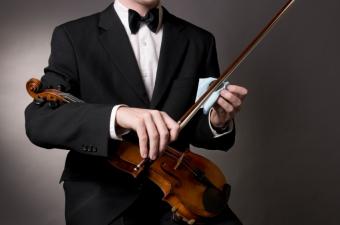At the Barre

The most essential piece of dance studio equipment is a barre. Coming in a close second is the mirror, but the barre is crucial. Here you see that young dancers will use the lower bar to place their hands on, and adult dancers will use the upper bar, but there are also different exercises and stretches for which adult dancers will sometimes use the upper and sometimes the lower bar.
The Mirror

A mirror is also essential dance studio equipment because without it, the dancer cannot perfect their own technique. A dancer who can see their own angles in the mirror can better understand the teacher's corrections and is able to see the recurring 'problems' in their form and correct them, to a certain extent, without constant reminding from the teacher.
'The Music, and the Mirror...'

A famous song from the musical 'A Chorus Line' repeatedly has the dancer sing 'All I ever needed, was the music, and the mirror....and the chance to dance, for you!'. Indeed, as the mirror is crucial, no dance studio is complete without music, either in the form of a piano in-house or a good sound system, preferably both. A piano is important to get dancers accustomed to dancing to live music, which is how the majority of ballet is performed.
Recorded Music

Just like live music is important, so is recorded music. Recorded music is primarily useful for non-ballet rehearsing, where a single piano is simply not complex enough (and also not loud enough!). Make sure to use a stereo system that is completely shock-proof, or (though it may sound old-fashioned) transfer CD and mp3 recordings to cassette if you can't afford a top-of-the-line CD player. All that jumping around makes CDs impractical.
Professional Flooring

While many dance studios have wooden floors, some use marley flooring because marley is what is laid on the vast majority of stages where dancers perform. Practicing on marley means there are no surprises when you try out the stage floor; in addition, marley is less slippery than most types of wooden flooring.
Traditional Wood Floor

Many dance studios follow tradition and have beautiful wooden floors. In most cases, these are quite slippery, which makes it difficult for the dancers to be able to practice freely. In addition, the gaps between planks in wooden flooring are much harder to 'iron out' than the rolling out of marley. If marley has been improperly rolled out, you simply take it up, re-roll it, and lay it and tape it again.
Help for Wooden Floors

If your dance studio has a wooden floor, you'll want to have a supply of rosin on hand for the dancers to chalk their shoes with. Rosin is actually for violin bows, but is used by dancers all over the world (especially on the tips of satin-covered pointe shoes) to increase grip on slippery surfaces.
First-Aid Kit

Like any place where sports are done, a good first-aid kit should be on hand at the studio. Ice packs should be stored in the freezer, and a standard first-aid kit should be well-stocked. Don't forget that the athletic tape is likely to be used more than anything else (to tape toes for pointe classes). Also have a lighter on hand (but not in the first-aid kit if there are small children who have access to it) to burn ribbons on shoes to prevent fraying and tripping on them. Safety pins, a needle and thread are also good items for the kit.
Sign up for our newsletter featuring all the latest stories and products we love.
Temperature Control

In some climates, where air conditioning is not a part of most buildings, you'll need to have some heavy-duty fans on hand in your studio. Especially in the summer months, a studio can become a sweltering (and not so nicely smelling) place to be. If possible, place bi-directional fans in front of windows in order to have the ability both to bring in fresh air and to blow out not-so-fresh air.
Lost and Found

Every dance studio needs a lost and found box and a box of 'spares'. Every night, forgotten items can be put into the lost and found box, hopefully to be claimed again by their owners. Every so often, unclaimed items can be moved to the 'spares' box.
Dancers who have outgrown certain shoes, leotards and tights can place these unwanted items in the spares box so that if someone forgot something, there's a chance of finding a pair of shoes to work with for that particular day. Try to stay away from having things like tutus in the box; only things to be used for class is enough.







